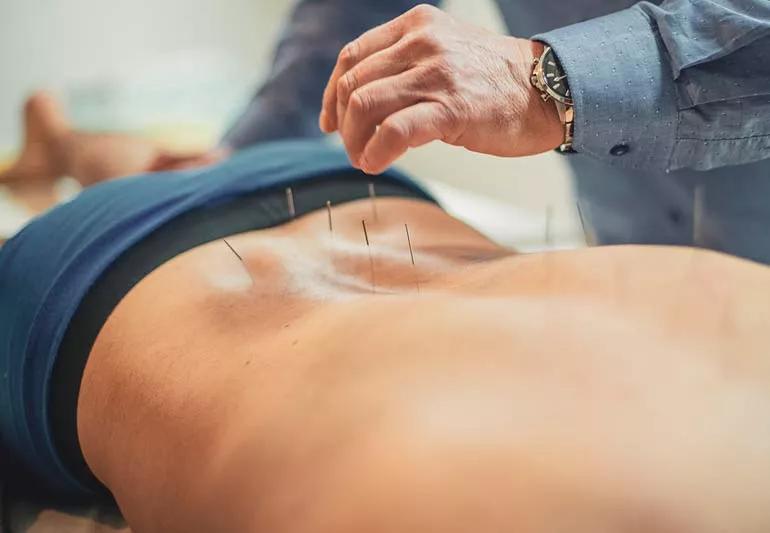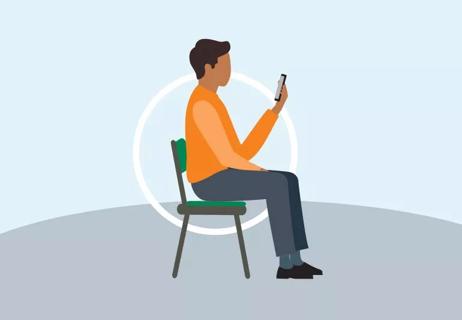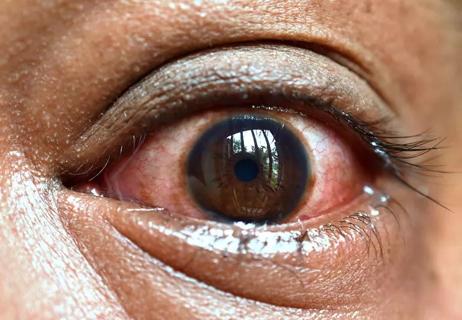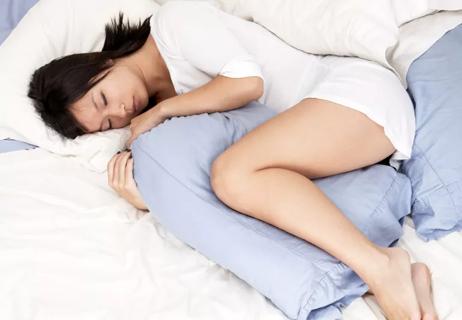Non-drug therapies like massage therapy and acupuncture can help manage pain, stiffness and fatigue

Are you dealing with hours of morning stiffness and waking up at night from back pain? The symptoms of ankylosing spondylitis (AS) — an inflammatory autoimmune disease — can make it difficult to move and focus on everyday tasks. In addition to taking medication prescribed by your physician, you might wonder if there are natural remedies for ankylosing spondylitis you can try.
Advertisement
Cleveland Clinic is a non-profit academic medical center. Advertising on our site helps support our mission. We do not endorse non-Cleveland Clinic products or services. Policy
Medication is the top priority, says rheumatologist Elaine Husni, MD, MPH. Your AS medication is essential to prevent AS from worsening. But many non-drug therapies are safe to try and may ease pain and stiffness. It’s a matter of seeing what works for you.
Dr. Husni weighs in on common ways to treat AS that you can do for yourself.
Clinical evidence doesn’t support the use of natural-only treatments for ankylosing spondylitis. These — including special diets or special supplements — can’t cure or prevent the disease from progressing. But, says Dr. Husni, they can reduce ankylosing spondylitis symptoms and complement your treatment plan.
“Don’t overlook drug therapy. It’s life-changing,” Dr. Husni says. “These days, with treatment, AS doesn’t progress to the end-stage. In the past, many people with AS had surgery or couldn’t do their daily activities like driving. Now, with treatment, most people don’t even know they have AS.”
Medication stops the disease from progressing. Non-drug therapies and lifestyle modifications can’t do that, but they can ease symptoms by boosting your health and lowering inflammation, a key factor in AS.
“Looking at your lifestyle behaviors is important for anyone with a chronic condition like AS,” says Dr. Husni. “Poor habits can make it difficult to get the disease under control.”
Advertisement
Because your lifestyle choices can play an important role in managing AS symptoms, try to:
Consider making changes to your diet. The right eating plan can give you more energy and reduce tummy troubles. There’s no specific AS diet. But many people feel better on an anti-inflammatory diet or primarily a plant-based diet that focuses on nutrient-dense foods that helps ease AS symptoms.
Exercise is especially crucial when you have AS. As the disease affects your spine, it’s important to strengthen muscles that support your back. Movement that helps you stay flexible and maintain a wide range of motion is essential, too. Exercises good for AS and easy on the joints include Pilates, body stretching and swimming.
“Tobacco use is linked to more aggressive cases of AS. The condition progresses faster and causes more damage to the spine and joints when you smoke,” explains Dr. Husni. Quitting smoking slows the disease and gives you a better quality of life. In addition to making treatment more difficult, smoking also:
A two-year study found that AS progressed much more rapidly in those who drank at least one serving of alcohol a week than in people who didn’t drink. “When you’re drinking a lot, you typically eat a less nutritious diet,” notes Dr. Husni. “High alcohol use also affects how your liver metabolizes medications.”
Having less pain and more movement makes life so much better. Non-drug therapies can be an important part of the treatment regimen, especially if you’re not getting enough relief from medications alone, says Dr. Husni.
Consider trying:
An easy home remedy for ankylosing spondylitis is applying hot or cold packs to achy muscles and joints. Heat relaxes muscles and increases blood flow, while cold reduces swelling. “One is not better than the other — just go with what temperature feels good to you,” advises Dr. Husni.
Many people consider seeing a chiropractor for back pain. But, says Dr. Husni, getting a back adjustment by a chiropractor may not cure or improve AS pain as it can for mechanical back pain symptoms. Instead, try massage therapy to relax muscles and increase range of motion. “Tell your massage therapist that you have AS so the therapist can adjust their technique accordingly,” Dr. Husni says.
Advertisement
If your pain isn’t well-controlled by medication, acupuncture may help. It’s a treatment used in traditional Chinese medicine. A trained acupuncturist inserts hair-thin needles into your skin at specific points. Researchers believe it may stimulate the release of chemicals that act as natural painkillers.
Your healthcare provider may recommend physical therapy as part of your AS treatment plan. During your sessions, you’ll do targeted exercises with supervision and assistance from a physical therapist (a health professional specializing in movement). A comprehensive analysis of the effectiveness of physical therapy found that it had many benefits for AS:
Transcutaneous electrical nerve stimulation (TENS) therapy is a pain-management tool. Physical therapists use it during sessions or may recommend a home device for you to use. It delivers small, electrical pulses to your muscles through electrodes (wires with sticky pads). Healthcare providers believe the treatment blocks nerves that signal pain and helps release endorphins, hormones that naturally lower pain.
Home treatments for ankylosing spondylitis can help manage your symptoms and put you back in the driver’s seat of your health.
Advertisement
Don’t underestimate how poor sleep or excess stress can affect your overall health. It’s important to have a regular sleep cycle and get enough hours of sleep per night.
It’s also vital to have a healthy way to reduce stress in your life. This can be as simple can making time to talk to a confidant, taking a walk outdoors or seeing a therapist if the stress is interfering with your daily activities. Talk to your healthcare provider about your plan — and keep on top of your medical treatment, too.
Advertisement
Learn more about our editorial process.
Advertisement

Some diets are better than others, but it comes down to what works best for you

Pilates, stretching and hydrotherapy can support your spine and maintain a wide range of motion

Doctors aren’t sure why, but the conditions are connected

Ease pain and stay active by keeping your spine in its proper position

About 35% of people with this autoimmune condition also develop uveitis

Managing the chronic pain of this autoimmune condition is important

Eating well can help reduce inflammation when you have endometriosis

Exercising and stretching your lower back, hamstrings, hips and quads can greatly improve your physical well-being

If you’re feeling short of breath, sleep can be tough — propping yourself up or sleeping on your side may help

If you fear the unknown or find yourself needing reassurance often, you may identify with this attachment style

If you’re looking to boost your gut health, it’s better to get fiber from whole foods